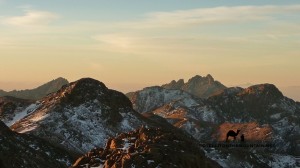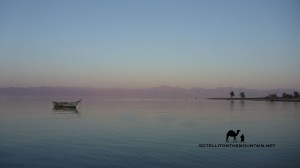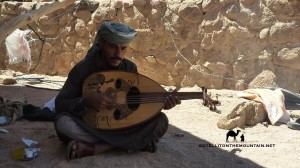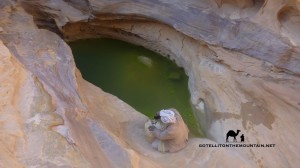Minimum impact travel
 The Sinai remained unsettled for most of its history; a land of rugged mountains and wild, windswept deserts. A few Bedouin tribes wandered. Everyone else – and there weren’t many – passed through on major desert roads such as the pilgrim trail to the Monastery of St Katherine or the Darb el Hajj to Mecca. That’s all changed today. The Sinai has seen more development than any other part of Egypt and millions of tourists visit every year. Tourism can be a force for positive change here but, all too often, it’s not. It’s important to travel in the right way, with an understanding of our impact on local people and the environment that remains crucial to them long after we go home. Here’s a quick guide to travelling in the most sustainable, positive way you can.
The Sinai remained unsettled for most of its history; a land of rugged mountains and wild, windswept deserts. A few Bedouin tribes wandered. Everyone else – and there weren’t many – passed through on major desert roads such as the pilgrim trail to the Monastery of St Katherine or the Darb el Hajj to Mecca. That’s all changed today. The Sinai has seen more development than any other part of Egypt and millions of tourists visit every year. Tourism can be a force for positive change here but, all too often, it’s not. It’s important to travel in the right way, with an understanding of our impact on local people and the environment that remains crucial to them long after we go home. Here’s a quick guide to travelling in the most sustainable, positive way you can.
ECONOMIC IMPACT
 President Hosni Mubarak turned South Sinai into Egypt’s ‘Red Sea Riviera’ in the 1990s, encouraging massive outside investment in the region. Hotels, casinos and gleaming shopping malls were built to transform a once-barren stretch of coast into one of the Middle East’s most prized stretches of real estate. Cairo’s political elite trumpeted it as a great success story, but few of the Bedouin saw it like that. They claim their land was sold without proper recompense. What’s more, they complain they had no real place in the big business beach economy built up on it afterwards. Bedouin unemployment is high and many have to ply illegal trades like smuggling to survive etc. Try to get your money where it’s really needed when you’re in the Sinai.
President Hosni Mubarak turned South Sinai into Egypt’s ‘Red Sea Riviera’ in the 1990s, encouraging massive outside investment in the region. Hotels, casinos and gleaming shopping malls were built to transform a once-barren stretch of coast into one of the Middle East’s most prized stretches of real estate. Cairo’s political elite trumpeted it as a great success story, but few of the Bedouin saw it like that. They claim their land was sold without proper recompense. What’s more, they complain they had no real place in the big business beach economy built up on it afterwards. Bedouin unemployment is high and many have to ply illegal trades like smuggling to survive etc. Try to get your money where it’s really needed when you’re in the Sinai.
Spread the wealth – big tourist resorts on the coast get more business than anywhere. By heading into the rugged Bedouin interior you’ll be making a difference already. Even here though, there are big inequalities. Help by heading for the region’s most little-known frontiers, like Wadi Feiran etc…
Support local business – choose small, locally-owned businesses over the big, international brands. Local shops, hotels and shisha cafes are run by local people who are genuinely connected to an area; they understand it, give it its character and face tough competition: HELP them by actually using them.
Encourage local trades – old Bedouin skills are being forgotten today but you can help preserve them by putting an economic incentive down. Buy Bedouin handicrafts as gifts; go to Bedouin storytelling evenings; employ a Bedouin herbalist or tracker to learn about plants and animals in the mountains etc.
CULTURAL IMPACT
 Back in the 1960s the population of South Sinai was about 5000: mostly Bedouin. But with Mubarak’s re-settlement policies, that figure boomed. In 2003 it was 100,000; it could be over 300,000 in 2017. Mainland Egyptians outnumber the Bedouin in the Sinai today. Westerners have a permanent, year-round presence in coastal resorts too. Relatively isolated in the wilderness before, Bedouin culture is more exposed to outside influence than ever today and it’s changing fast; some say at such a speed nobody knows whether it’s for better or worse; which change they want, which they don’t and whether they have a choice anyway. Change will happen; and whether it’s good or bad is a Bedouin debate; but you can still remind them of what you like about their culture.
Back in the 1960s the population of South Sinai was about 5000: mostly Bedouin. But with Mubarak’s re-settlement policies, that figure boomed. In 2003 it was 100,000; it could be over 300,000 in 2017. Mainland Egyptians outnumber the Bedouin in the Sinai today. Westerners have a permanent, year-round presence in coastal resorts too. Relatively isolated in the wilderness before, Bedouin culture is more exposed to outside influence than ever today and it’s changing fast; some say at such a speed nobody knows whether it’s for better or worse; which change they want, which they don’t and whether they have a choice anyway. Change will happen; and whether it’s good or bad is a Bedouin debate; but you can still remind them of what you like about their culture.
The West: tell it like it is – if you find the ‘West is best’ mentality, respond fairly. Acknowledge the good parts of the West: higher standards of living, better healthcare, democracy etc. But just balance it out with the bad sides too: higher rates of violent crime, homelessness, family breakdown etc.
Encourage local pride – taking an interest in local culture breeds pride. Tell people when you see something you like as it underlines its importance and reminds them to value it. And ask questions Bedouin place names, starlore and other knowledge as it’ll help keep it in circulation too.
Aim to understand – Local culture has different norms to Western culture, on everything from dress to religion and how an animal should be killed. Ask questions, listen and really try to understand why the local culture adds up as it does; finding commonalities can be as interesting as differences.
ENVIRONMENTAL IMPACT
 Until recently the interior of the Sinai was accessible only on foot or on the back of a camel. Only the hardiest, most intrepid of travellers ventured in. Today, many parts of the desert can be reached by jeeps and ever-growing numbers of tourists are visiting its canyons and oases or are climbing popular peaks like Mount Sinai. Too many of these folks come in and out on speedy day trips from big, coastal resorts; they don’t spend time in the wilderness areas, getting to understand them, and why they’re worthy of protection. They don’t live with them, connect with them, or see how local people use them every day; many don’t see any reason to preserve them once they’ve gone. Remember: the Bedouin live close to the land and the desert takes a long time to recover.
Until recently the interior of the Sinai was accessible only on foot or on the back of a camel. Only the hardiest, most intrepid of travellers ventured in. Today, many parts of the desert can be reached by jeeps and ever-growing numbers of tourists are visiting its canyons and oases or are climbing popular peaks like Mount Sinai. Too many of these folks come in and out on speedy day trips from big, coastal resorts; they don’t spend time in the wilderness areas, getting to understand them, and why they’re worthy of protection. They don’t live with them, connect with them, or see how local people use them every day; many don’t see any reason to preserve them once they’ve gone. Remember: the Bedouin live close to the land and the desert takes a long time to recover.
Watch the water – every bit of the Sinai’s a desert and water’s like gold for surviving here. Save every last drop. Go without a shower, wash clothes when you’re back in town; clean pots and pans with bread etc. Watch water purity too: never use soap, clean teeth or wash pots directly in a water source etc.
Be smart with fire – fires are central to Bedouin culture but – in some areas – wood is getting scarce now. If you can, use gas; otherwise, dry camel droppings can be good for small fires. If you DO use wood, follow the Bedouin example and ONLY use deadwood. Or buy it before you go out to town.
Take care with litter – anything flammable like paper, cardboard etc can be used as FIRELIGHTERS on the trail. What you can’t burn, take out with you. To really set a good example, pick up bits of litter up you see when you’re out; I do this whenever I can and it DOES make a difference.